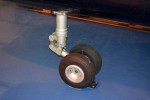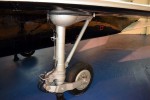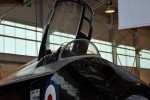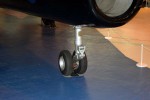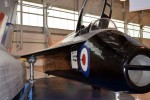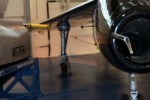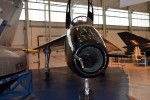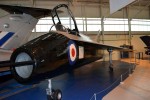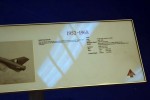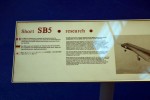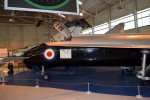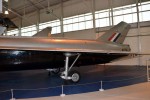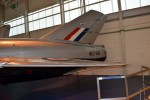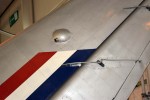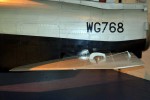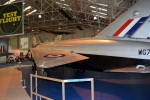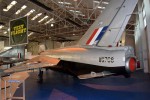1⁄1Short Brothers SB5 WG768
The SB5 was built to compare theories on the design of the wing and tail configuration of a new fighter, later to be known as the Lightning.
A technical dispute arose between the Royal Aircraft Establishment and the English Electric Company (EEC) as to the best configuration for a proposed new supersonic fighter. A research machine was built to investigate the low speed handling of the possible configurations. The contract was awarded to Short Brothers and Harland Ltd of Belfast on 2 August 1950. The machine was designed to allow three different wing sweep angles (50°, 60° and 69°) and two different tail plane positions, (low on the rear fuselage and on top of the fin). This necessitated two entirely different rear fuselages and tail units.
Over the next eleven months the tests with 50° and 60° sweep were concluded with the high tail configuration. In January 1954 the low tail rear fuselage was fitted and tests continued for a further two years and proved that the EEC configuration was correct.
Before fitting the final wing sweep configuration of 69°, an ejector seat was fitted for the first time and the Rolls-Royce Derwent engine was changed for a Bristol Orpheus of greater thrust. The aircraft was returned to RAE Bedford in September 1960. The first flight was made in the new configuration on 18 October. After completion of its test programme the Empire Test Pilots School at Boscombe Down flew the machine to give students experience in flight-testing slender aircraft.
A technical dispute arose between the Royal Aircraft Establishment and the English Electric Company (EEC) as to the best configuration for a proposed new supersonic fighter. A research machine was built to investigate the low speed handling of the possible configurations. The contract was awarded to Short Brothers and Harland Ltd of Belfast on 2 August 1950. The machine was designed to allow three different wing sweep angles (50°, 60° and 69°) and two different tail plane positions, (low on the rear fuselage and on top of the fin). This necessitated two entirely different rear fuselages and tail units.
Over the next eleven months the tests with 50° and 60° sweep were concluded with the high tail configuration. In January 1954 the low tail rear fuselage was fitted and tests continued for a further two years and proved that the EEC configuration was correct.
Before fitting the final wing sweep configuration of 69°, an ejector seat was fitted for the first time and the Rolls-Royce Derwent engine was changed for a Bristol Orpheus of greater thrust. The aircraft was returned to RAE Bedford in September 1960. The first flight was made in the new configuration on 18 October. After completion of its test programme the Empire Test Pilots School at Boscombe Down flew the machine to give students experience in flight-testing slender aircraft.
Copyright ©2021 by Darren Baker. Images also by copyright holder unless otherwise noted. The views and opinions expressed herein are solely the views and opinions of the authors and/or contributors to this Web site and do not necessarily represent the views and/or opinions of AeroScale, KitMaker Network, or Silver Star Enterrpises. Images also by copyright holder unless otherwise noted. Opinions expressed are those of the author(s) and not necessarily those of AeroScale. All rights reserved. Originally published on: 2016-12-12 00:00:00. Unique Reads: 10238





